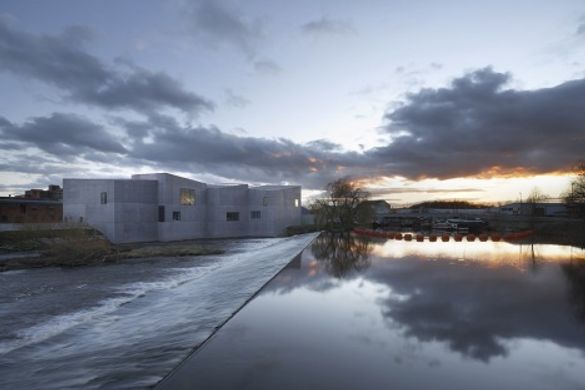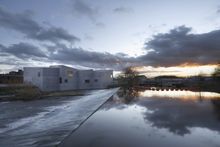 15 Jan 2015
15 Jan 2015
The place of the contemporary visual arts in British society has been transformed over the last twenty years. The Plus Tate network, bringing eighteen cultural institutions together with Tate, provides a snapshot of this dynamic creative ecology. Research published today, Plus Tate: Connecting Art with People with Places, reveals the huge regenerative and economic benefits of this group of organisations. The success of Plus Tate has led to plans to expand the network in spring 2015.
Together the Plus Tate partners, excluding Tate sites
· attract 3.5 million visits annually;
· employ around 500 staff;
· collectively have an annual turnover of around £33 million.
The wider public benefit does not just stop at the gallery door. In addition to extensive exhibition and learning programmes around international contemporary art, each institution is deeply committed to working with their local community attracting new and diverse audiences to art. Their onward supply chains generate substantial economic benefit.
Nicholas Serota, Director Tate said “The impact across communities through the imaginative work of these dynamic visual arts organisations has been transformational. Their ongoing success, however, depends on continuing strategic investment. We must make sure we nurture a creative asset that is admired across the world.”
Ends
Notes to Editors
Plus Tate
Plus Tate is one of Tate's best-established networks. Established in 2010, the partnership brings Tate together with eighteen partner organisations across the UK. The Plus Tate partners are: Arnolfini, Bristol; BALTIC Centre for Contemporary Art, Gateshead; Cornerhouse, Manchester; firstsite, Colchester; Glynn Vivian Art Gallery, Swansea; Grizedale Arts, Coniston, Cumbria; The Hepworth Wakefield; Ikon, Birmingham; Kettle's Yard, Cambridge; mima, Middlesbrough; MOSTYN, Llandudno; Newlyn Art Gallery and The Exchange, Penzance; Nottingham Contemporary; The Pier Arts Centre, Stromness, Orkney; Towner, Eastbourne; Turner Contemporary, Margate; Whitworth Art Gallery Manchester; and Wysing Arts Centre, Bourn, Cambridgeshire.
Plus Tate partners share information, for example on developing philanthropy, integrated programming, social and cultural value, leadership development and best practice in digital audience analysis. Important benefits generated so far by the partnership have been the positive regenerative effects produced through exhibition, learning and wellbeing programmes and support for the cultural and the creative sectors through commissioned works of art and artist development.
Additional Press Information
Highlights of the Plus Tate partner organisations
Since 2009 the youth group established at Bristol's flagship contemporary art gallery, Arnolfini has engaged thousands of young people. Bringing together Bristol's dynamic art scene and young people, 11,500 participants took part in Young Arnolfini programme last year alone and a new local partnership project involving 50 art installations at 50 primary schools will reach 25,000 children.
BALTIC, Gateshead welcomes over 500,000 visitors each year has become the focal point for a remarkable story of regeneration in the area. The gallery's experiential learning space hosts 200,000 visitors every year. A partnership with Northumbria University has created Baltic 39, a creative hub with 32 studios.
With its strong green agenda, Cornerhouse/Home in Manchester is a multi-disciplinary artistic centre to be housed in a new building in 2015. Cornerhouse's education work with children aged 8 to 18 supports Manchester City Council's wider approach to providing opportunities for young people.
Welcoming over 420,000 visitors since opening in 2011, firstsite in Colchester marries the needs of artists and audiences while nurturing artistic talent. The recently launched Essex Network of Artists' Studios (ENAS), a new initiative for artists and studios in its first six months grew to include over 300 members across 16 studios throughout the county.
The Glynn Vivian Art Gallery plays a major role in initiatives to tackle poverty, unemployment and social exclusion faced by people living in Swansea. It has been an active contributor to the One Swansea Plan developed by Swansea Council, acting as a vital connector and community activist.
The Lake District's Grizedale Arts works with around 40 British and international artists each year and is internationally recognised for its work with rural communities. Grizedale's The Honest Shop is housed in the Coniston Institute, stocked and managed by village residents.
Since opening in 2011, The Hepworth Wakefield has welcomed 1.2 million visitors. Its success has helped to secure significant private funding to restore neighbouring listed mills and warehouses. The gallery has become a global destination and forms part of the Yorkshire Sculpture Triangle comprising nearby Yorkshire Sculpture Park, Leeds Art Gallery and The Henry Moore Institute
Birmingham's Ikon Gallery, founded in 1965, brings international art to around 130,000 visitors a year, challenging negative beliefs about public engagement with contemporary art. It also generates huge economic benefit for the city annually, and has commissioned a bronze sculpture titled Real Birmingham Family by Turner Prize winning artist Gillian Wearing.
The captivating Kettle's Yard is planning an £8.7 million capital programme to support a new Education wing and with improved facilities. Kettle's Yard is a vital member of the university community in Cambridge and has a number of strategic partnerships designed to address the anticipated 30% population growth in the area in the next 20 years.
mima in Middlesbrough is symbolic of and active in engendering pride in the city. Housed in Erick van Egeraat's civic building, the gallery engages people of all ages and backgrounds and generates £1.1 million through its supply chain and a further £400,000 in economic benefit through additional spend by its visitors.
MOSTYN is Wales's leading contemporary art gallery. It welcomes over 80,000 people each year bringing over £600,000 of economic benefit in and around Llandudno through a combination of its supply chain and induced spending, and £700,000 economic benefit generated by additional spend attributable to MOSTYN's visitors.
Newlyn Art Gallery & The Exchange in Penzance provide a platform to showcase contemporary international art and contribute over £500,000 to the local Cornish economy annually through comb ined supply-chain and induced spending. A further £500,000 of economic benefit is attributable to additional spend by visitors to Newlyn and The Exchange. They form a key part of the cultural scene by nurturing the creative industries in Cornwall.
Nottingham Contemporary, opened in 2009, has featured nearly 200 international artists so far. Its dynamic programme is complemented by a commitment to public debate and scholarship through a strategic partnership with Nottingham Trent University and the University of Nottingham. The gallery's Loudspeaker project aims to raise the voices and aspirations of local women and is among many projects making its work relevant to the local community.
In Stromness the gift of a collection of modern and contemporary art led to the success of The Pier Arts Centre, contributing £1.1 million a year to the Orcadian economy in spending beyond the gallery. The Pier Arts Centre is a vivid example of the way in which a small but exquisite collection, along with a dedicated team, can inspire a community.
The Towner in Eastbourne, known for its modern British art and growing collection of international contemporary works, aims to give the entire local community ownership of the gallery. It supports a range of public programmes including in drug rehabilitation and mental health and has worked with over 1,000 young offenders.
92,000 young people have taken part in activities at Turner Contemporary, which has transformed the town of Margate and attracted more than 1.4 million visits in 3.5 years since opening, driving the local economy through tourism and inward investment. Long term community initiatives have instilled pride and strong local engagement.
The Whitworth Art Gallery, part of the University of Manchester, has seen its numbers increase by 120% since 2005 to 190,000 annually – and is expected to rise further with the completion of major capital investment. Projects like Art Baby, an award-winning programme for small babies, their parents and carers, are building strong community relationships.
Wysing Arts Centre supports artists on a rural site in Cambridgeshire and enjoys an international reputation. It engages nearly 100,000 visitors and participants in its wide-ranging programmes and works with local community, other academic institutions both nationally and internationally. Wysing is the lead cultural partner in an ambitious sustainable retrofit programme for large parts of the medieval city.
Press Contact
To view Plus Tate: Connecting Art with People with Places visit www.tate.org.uk/about/our-work/national-partnerships/Plus-Tate
For further information, please contact Ruth Findlay at ruth.findlay@tate.org.uk; or call +44(0)20 7887 4941 or +44(0)207 887 8730.


